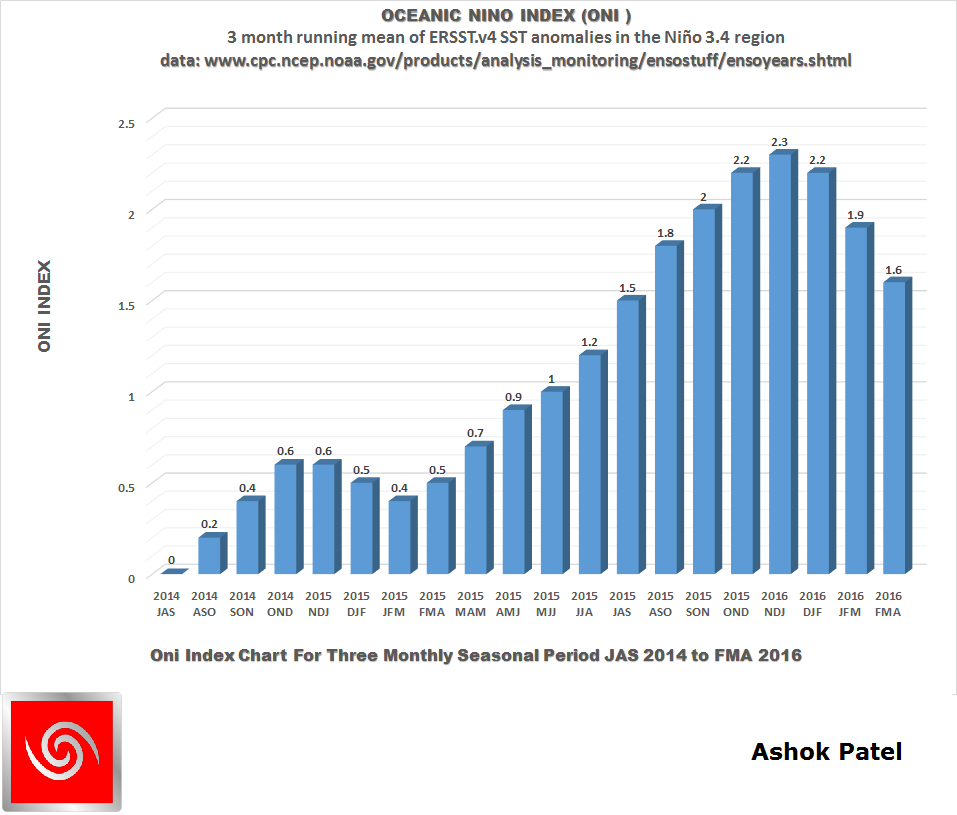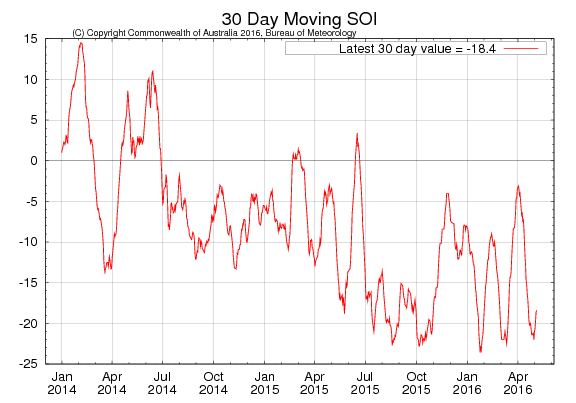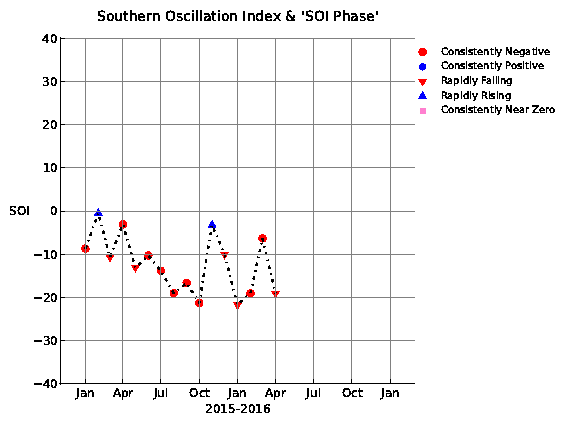El Nino Status on 7th May 2016
The ONI is based on SST departures from average in the Niño 3.4 region, and is a principal measure for monitoring, assessing, and predicting ENSO. Defined as the three-month running-mean SST departures in the Niño 3.4 region. Departures were based on ERSST.v3b till June 2015 and from then on wards are now based on a set of improved homogeneous historical SST analyses (Extended Reconstructed SST – ERSST.v4). The SST reconstruction methodology is described in Huang et al., 2015, J. Climate, vol. 28, 911-930.).
NOAA Operational Definitions for El Niño and La Niña El Niño: characterized by a positive ONI greater than or equal to +0.5ºC. La Niña: characterized by a negative ONI less than or equal to -0.5ºC. By historical standards, to be classified as a full-fledged El Niño or La Niña episode, these thresholds must be exceeded for a period of at least 5 consecutive overlapping 3-month seasons.
CPC considers El Niño or La Niña conditions to occur when the monthly Niño3.4 OISST departures meet or exceed +/- 0.5ºC along with consistent atmospheric features. These anomalies must also be forecast to persist for 3 consecutive months.
The current El Nino event was confirmed at the end of August 2015 considering the SST departures from average in the Niño 3.4 region based on Extended Reconstructed SST – (ERSST.v4). The graph below shows that currently, a strong El Nino persists till end of April 2016, the last available 3 monthly season being FMA 2016.
Latest Oceanic Nino Index (ONI) Graph till April 2016

The Table below shows the monthly SST of Nino3.4 Region and the Climate adjusted normal SST and SST anomaly for last two years.
Period Nino3.4 ClimAdjust
YR MON Temp.ºC Temp.ºC ANOM ºC
2014 4 27.73 27.85 -0.12
2014 5 28.02 27.96 0.06
2014 6 27.69 27.73 -0.04
2014 7 27.28 27.31 -0.02
2014 8 26.90 26.96 -0.06
2014 9 27.03 26.87 0.16
2014 10 27.25 26.83 0.42
2014 11 27.51 26.78 0.74
2014 12 27.40 26.73 0.68
2015 1 27.22 26.71 0.51
2015 2 27.25 26.89 0.36
2015 3 27.79 27.37 0.42
2015 4 28.59 27.85 0.73
2015 5 28.83 27.96 0.87
2015 6 28.70 27.73 0.97
2015 7 28.50 27.31 1.20
2015 8 28.47 26.96 1.51
2015 9 28.62 26.87 1.75
2015 10 28.86 26.83 2.03
2015 11 29.14 26.78 2.36
2015 12 29.04 26.73 2.31
2016 1 28.94 26.71 2.23
2016 2 28.89 26.89 2.00
2016 3 28.87 27.37 1.50
2016 4 29.03 27.85 1.18
February, March, & April 2016 SST anomaly for Nino3.4 region is used to calculate the latest ONI Index for FMA 2016 as +1.6ºC. Since the latest ONI Index is yet above +1.5ºC, the El Nino is classified as a Strong El Nino till end of April 2016. The SST anomaly for April 2016 was +1.18ºC and so the next 3 months season ONI for MAM 2016 will remain below +1.5ºC , thereby the El Nino will have weakened by next month.
CPC considers El Niño or La Niña conditions to occur when the monthly Niño3.4 OISST departures meet or exceed +/- 0.5°C along with consistent atmospheric features. These anomalies must also be forecast to persist for 3 consecutive months.
Southern Oscillation Index
As per BOM, Australia: The Southern Oscillation Index (SOI) has dropped to -22.0 at the end of April 2016 remaining firmly in the negative areas. The latest 30-day SOI value to 5th May 2016 is −18.4.

Sustained positive values of the SOI above +7 may indicate La Niña, while sustained negative values below −7 may indicate El Niño. Values of between about +7 and −7 generally indicate neutral conditions.
SOI Monthly graph till end of April 2016 was -19.07 as per The Long Paddock – Queensland Government. The Latest 6th May 2015 30 days SOI was -16.72 .

Summary by: Climate Prediction Center / NCEP Dated 2 May 2016
ENSO Alert System Status: El Niño Advisory/ La Niña Watch El Niño is present and is weakening.* Positive equatorial sea surface temperature (SST) anomalies continue across most of the Pacific Ocean. A transition to ENSO-neutral is likely during late Northern Hemisphere spring or early summer 2016, with an increasing chance of La Niña during the second half of the year.*
* Note: These statements are updated once a month (2nd Thursday of each month) in association with the ENSO Diagnostics Discussion, which can be found by clicking here
As per BOM -Australia : El Niño enters its final weeks
The 2015–16 El Niño is in its last stages. Recent changes in the tropical Pacific Ocean and atmosphere, combined with current climate model outlooks, suggest the likelihood of La Niña forming later in 2016 is around 50%, meaning the Bureau’s ENSO Outlook is at La Niña WATCH.


